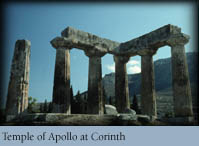
Sitting astride an isthmus, Corinth served two harbors: Lechaion to the north and Cenchreae to the East. Along the shipping lanes and through the bustling warehouses passed luxury goods -- leather, linen, wine, oils and fine marble -- that appealed to the tastes of the city's wealthy residents. Religious practice followed trade routes. Besides Apollo, Athena, Aphrodite, and Asclepius, the residents of Corinth paid homage to foreign as well as civic deities.
It was to this sophisticated metropolis that the apostle Paul brought his message of "Jesus Christ and him crucified." Tradition claims that Paul was a tent maker, and that he first carried his message to other engaged in the same trade, including the couple identified in his letters as Prisca and Aquila.
But Paul's' letters also indicate that he made early converts further up the social scale. Their names, both men and women, are recorded in his correspondence: Chloe, Stephanus, Gaius, Crispus, and Erastus. An inscription from Corinth mentions a city treasurer by that name. Was he a Christian from one of Paul's churches? All that we know for certain is that these early converts were incredibly diverse. They met together as small communities in the larger homes of the wealthier members. These meeting places eventually evolved into "house churches."
Once Paul had established a group of these Christian churches, Paul moved on to Ephesus. But internal squabbles threatened to tear his house churches apart. There were conflicts over immoral behavior, spiritual gifts, and dining with pagans. Sometimes Paul tried to mediate these conflicts by sending an emissary; other times, he responded with letters.
Two of the letters now contained in the New Testament were addressed to Paul's house churches in Corinth, and express an idea central to his preaching: those who become Christians agree to set aside differences of gender, ethnicity, and class, and join together into one community:
For just as the body is one and has many members, and all the members of the body, through many, are one body, so it is with Christ. For in the one Spirit we were all baptized into one body -- Jews or Greeks, slaves or free -- and we were all made to drink of one Spirit.
(1 Cor 12:12-13).